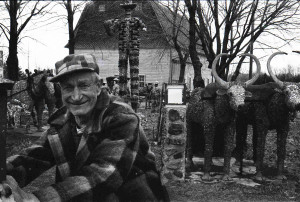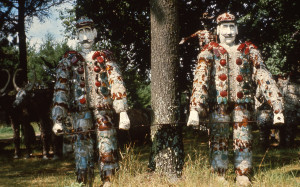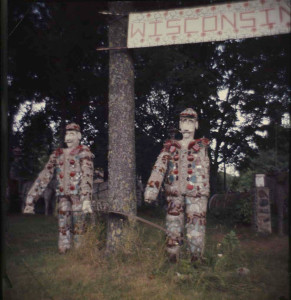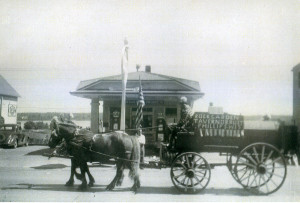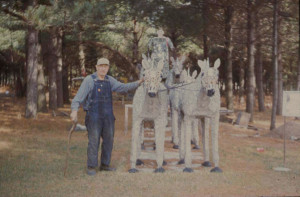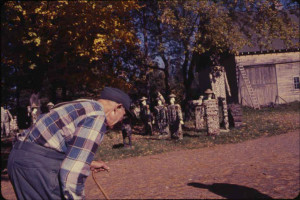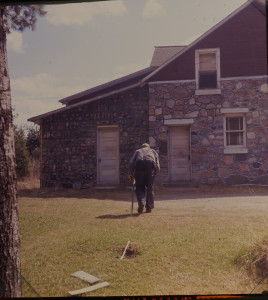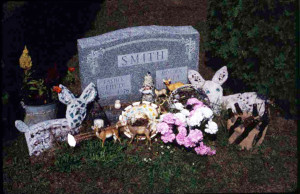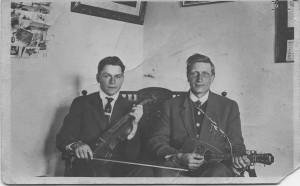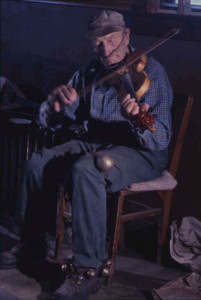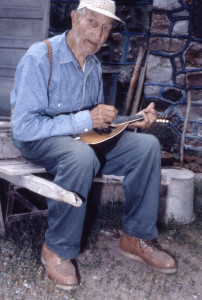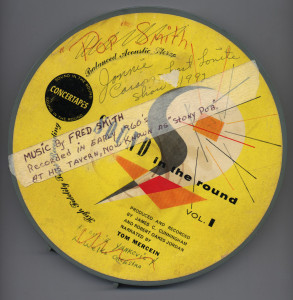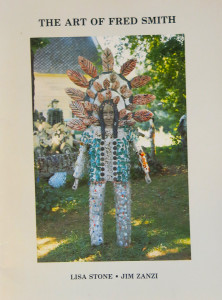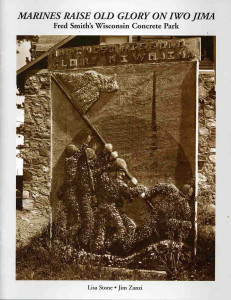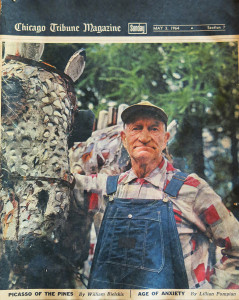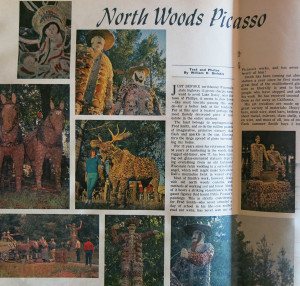About Fred Smith
Fred Smith was born on September 20, 1886, to immigrant German parents who settled in Ogema, Wisconsin, about 20 miles south of Phillips. He had no formal schooling, and was illiterate. In later life Smith was asked if he had been hindered by his inability to read or write, and he replied: “Hell no, I can do things other people can’t do!”
- Amft portrait
- Paul Bunyan’s Lumberjacks, site plan #3. Photo: Gregg Blasdel, c. 1960s
Smith began work in lumber camps near Spirit, Wisconsin in his early teens, and continued to work in the woods, in winters, for about fifty years. For 99 cents per day, his beginning wage, Smith arose in the cold and dark, working with large horses and gigantic, hand-operated logging tools to cut and transport the giant pines. He said, I made just that little bit of money and lived 5 kids and a woman on that money. Never made no debts, never! That goes to show what people can do!
- Paul Bunyan’s Lumberjacks, site plan #3. Photo: Robert Amft, c. 1960-64.
- Original Smith house. Photo courtesy Robert Tripp
Smith homesteaded 120 acres just south of Phillips, in 1903, where he raised five children with his wife Alta. He grew ginseng, which he sold to New York markets, and raised Christmas trees, which he sold locally. The original Smith house burned in 1922, and was replaced with a sturdy, Craftsman style house that may have been ordered from Sears and Roebuck. Smith transformed the south-facing sun porch into a plant-filled Rock Garden Room for Alta. A long brick trough filled with a rock-scape featured a fountain with running water. Right outside was Smith’s elaborate Rock Garden.
- Second Smith family house. Photo: Robert Amft
- Rock Garden Room today. Fountain was in the rocky area in middle of the brick trough, that runs the length of the room.
- Fred Smith’s Rock Garden, date and photographer unknown. A corner of the Smith house is on the left (north). Behind the elaborate garden beds outlined with rocks are the sheds where Smith grew ginseng. This is the only known photo of the Rock Garden.
Smith built his Rock Garden Tavern south of the Rock Garden in 1936, with John and Albert Raskie. The Raskie brothers had built impressive stone buildings in the area, using fieldstone with tinted, rope-style mortar joints. He made ingenious, homemade concrete blocks for an addition to the Tavern. He painted signs and images on boulders around the driveway. Smith recalled, I just had Rhinelander beer. Only one beer! I bought a truck load of beer every time we went to Rhinelander. 200 cases every time.
- Fred Smith (right) and friends at the Rock Garden Tavern. Photo courtesy Robert Tripp
- Rock Garden Tavern. Photo: Jim Zanzi, c. 1960s
- Deer painting on boulder, Rock Garden Tavern parking area. From the Movie Ben Hur tableau in background. Photo: Robert Amft, c. early 1960s
- Rock Garden Tavern. Photo, Jim Zanzi, c. 1960s
- Rock Garden tavern painted rock. Photo: Robert Amft, c. 1960s
- Rock Garden Tavern with back bar sculptures. Photo: Karen Savage, c. 1960s
Possibly wanting to make sculpture in the winter, when he was not able to work outside, Fred Smith made a number of decorative plaques for the back bar. See More Photos for back bar sculptures.
- Rock Garden Tavern back bar. Photo: Robert Amft, c. 1960s
- Smith in Phillips Parade
- Fred Smith in the Rock Garden Tavern. Note back bar sculptures. Photo: Robert Amft, c. early 1960s.
- Detail, Rock Garden Tavern wall. Left: 1936 masonry by the Raskie Brothers. Right: Tavern addition with Fred Smith’s homemade concrete blocks.
- Detail, Smith’s homemade concrete blocks, made for an addition to the Rock Garden Tavern (date of addition unknown). Photo: Jim Zanzi
In about 1948 Smith stopped working in the lumber camps. It’s been said that he retired due to his severe arthritis, but his long days of rigorous physical work were far from over. He launched into a 15-year creative burst in which his home and tavern landscapes became his studio. The scale of lumber work, popularly portrayed in the Paul Bunyan tall tales, undoubtedly influenced Smith’s larger-than-life approach to his art. He didn’t set out to create 237 life-size and larger-than-life sculptures in fifteen short working seasons, which would seem ambitious for most, but especially for a man nearly crippled with arthritis. Like many artists, his work evolved out of a love for making, for working and thinking with his hands. He made sculptures honoring Native American Indians, regional settlers, local myths and legends, figures and animals, and events of national, local and deeply personal significance. He said, Nobody knows why I made them, not even me. This work just came to me naturally. I started one day in 1948 and have been doing a few a year ever since. He named his roadside attraction the Wisconsin Concrete Park.
As he became consumed with this monumental project, Smith spent less time with his family. Like many artists, he experienced the conflict between the demands of his art and his home life. His commitment to his art was not well understood or accepted, but he knew it was larger than life, and continued to work in the spite of harsh criticism. I put in so many hours daylight to dark. I figured I didn’t have much time to do all that work. Ya gotta get the work done.
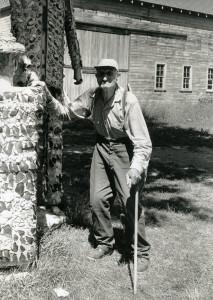
Fred Smith at The End of the Road tableau. Photo: Gregg Blasdel, c. 1960-64
Smith loved to show visitors his sculpture and was delighted when people showed interest in his work. Although a few local people admired his work, many people thought he was crazy; some considered the site an eyesore and hoped it would be destroyed. Smith knew his work was important and that it was essential for people not only to see it, but to see it exactly where it was built. He only made one sculpture (a deer) for a friend, and refused to sell anything or to accept commissions. He said, I welcome visitors. I like to watch their reactions. But I never sell any ‘cause it might spoil it for others.
- Fred Smith with “From the Movie Ben Hur” horse team. Photo: Robert Amft,c. 1960-64
- Fred Smith. Photographer unknown.
In 1964, shortly after Smith finished the last horse in his Budweiser Display, he suffered a stroke. He was moved to a rest home in Phillips, not far from the Park. Years later he described the incident to Jim Zanzi, I remember when I finished the last of the Bud Beer horses…Yeah, I finished them and they were just right. The next morning I woke up and I didn’t know where I was at. The kids were around and they went and got Doc Nebor and he said “this man is dead”. I looked up at him and said I’m going to have a lot of fun with my time!
- Fred Smith portrait. Photo: Robert Amft, c. 1960-64
- Fred Smith walking to the Rock Garden Tavern. Photo: Robert Amft, c. 1960-64
Smith spent his last eleven years in the rest home, dreaming of sculptures that he could no longer build. Early in 1976 he told Zanzi, Pretty soon I’m going over the moon. He died on February 21st that year. Smith is buried with his wife Alta in Lakeside Cemetery in Phillips. Friends and admirers continue to pay homage by ornamenting his grave.
- Fred Smith in the rest home. Photo: Jim Zanzi, c. 1975
- Fred Smith in the rest home. Photo: Jim Zanzi, c. 1975
- Fred and Alta Smith grave, Lakeside Cemetery, Phillips, Wisconsin. Photo: Robert Amft, c. 1989Amft Grave
Fred Smith's Music
Music was a vital force in Smith’s life, from childhood into his old age. He made his first fiddle when he was twelve, using a cigar box and horsehair.
He entertained tavern patrons, playing the fiddle and mandolin with sleigh bells tied to his knees and ankles. His performances were exuberant–– dancing, singing, playing, and occasionally, jumping from table to table, at dances in his barn.
- Fred Smith in the Rock Garden Tavern. Photo: Robert Amft, c. 1960s
- Schwalbach Smith portrait
- Fred Smith playing in the Tavern.
- Fred Smith playing in the Tavern. Photo: Robert Amft
- Fred Smith playing in the Tavern, reflected in the mirror. Photo: Robert Amft
Fred Smith played traditional tunes with a highly original spin. His music, preserved on the only known recording, is eccentric, rhythmic, and meditative.
Track 1
Track 2
Track 3
Track 4
Track 5
Track 6
Track 7
Track 8
- Fred Smith with mandolin. Photo: Robert Amft
- Fred Smith with young boy. Photo: Robert Amft
- Fred Smith’s fiddle. Photo: Robert Amft
Fred Smith created a Bandstand (site plan #28) with four musicians on a concrete slab atop a large rock are right near the site where a large barn, destroyed by the storm of 1977, stood. The wild dances that took place in the barn were legendary. Smith recalled, We used to have two taps…in the moonshine days. One tap downstairs in the barn and moonshine upstairs. They would go upstairs to get the moonshine and then roll down the stairs. Oh Jesus Christ! They would drink big schooners of beer. We just all had a good time! I’ve been having a good time all my life!
- Bandstand with Nativity Plaques, site plan #28. Photo: Karen Savage, c. 1960s
- Musicians on Bandstand with Nativity Plaques, site plan #28. Photo: Robert Amft, c. 1960s
- Musician on Bandstand with Nativity Plaques, site plan #28. Photo: Roger Brown, c. 1971-1972

Reference Material and Sources
Fred Smith in print
Books and catalogs
Beardsley, John. Gardens of Revelation Environments by Visionary Artists. New York: Abbeville Press (1995): 80-85.
Cole, Wanda G., Grass Roots Art: Wisconsin Toward a Redefinition. Sheboygan, WI: John Michael Kohler Arts Center (1978): 38.
Hall, Michael D. “ Memory and Mortar: Fred Smith’s Wisconsin Concrete Park,” Stereoscopic Perspective: Reflections on American Fine and Folk Art. Ann Arbor: UMI Research Press (1988): 173-84.
Hartigan, Lynda Roscoe. Made With Passion: The Hemphill Folk Art Collection in the National Museum of American Art. Washington and London: Smithsonian Institution Press, (1990): 55.
Hoos, Judith, and Blaisdel, Greg. “Fred Smith’s Concrete Park.” Naives and Visionaries. An exhibition organized by Walker Art Center. Minneapolis: E.P. Dutton & Co., Inc. (1974): 53-59.
Hemphill, Herbert W., and Julia Weissman. 20th Century Folk Art and Artists. New York: E.P. Dutton, & Co. Inc. 1974.
Sackett, F.W. Comp. A Glimpse at the Early History of the State of Wisconsin Relating to Price County. Unpublished manuscript, Phillips, Wisconsin, 1901.
Sellen, Betty-Carol. 20th Century American Folk, Self-Taught, and Outsider Art. New York: Neal Schuman Publishers, Inc. (1993): 416.
Stone, Lisa, and Zanzi, Jim. The Art of Fred Smith. Phillips, WI: The Wisconsin Concrete Park/Weber & Sons (1991, 1997, 2005).
Stone, Lisa, and Zanzi, Jim. Marines Raise Old Glory on Iwo Jima. Phillips, WI: The Wisconsin Concrete Park/Weber & Sons, 2009.
Stone, Lisa, and Zanzi, Jim. “Fred Smith’s Wisconsin Concrete Park” Sacred Spaces and Other Places A Guide to the Grottos and Sculptural Environments of the Upper Midwest. Chicago: The School of the Art Institute of Chicago Press (1993): 104-123.
Trestrail, Joanne. Wisconsin The Spirit of America. New York: Harry N. Abrams Press, 2001. WCP on p. 80.
Umberger, Leslie, “Fred Smith (1886-1976) Not Just Another Roadside Attraction,”Sublime Spaces & Visionary Worlds: Built Environments of Vernacular Artists. New York: Princeton Architectural Press ; [Sheboygan, Wis.]: John Michael Kohler Arts Center, 2007
Wertkin, Gerard C., Editor. Encyclopedia of American Folk Art. New York / London: Routledge, in association with the American Folk Art Museum (2004). 492-93.
—– 100 Years of Wisconsin Art, 1888-1988: A Centennial Celebration. Milwaukee, Wisconsin: Milwaukee Art Museum, (1988): 112-113.
ARTICLES
Bielskis, William H. “North Woods Picasso.” Chicago Tribune Magazine, (May 3, 1964): 32-34
Blasdel, Gregg N. “The Grassroots Artist.” Art In America. (September/October 1968): 24-41.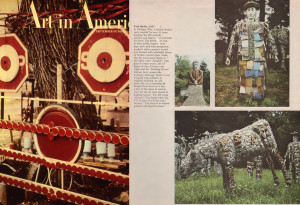
——- “Grandpa Moses of Cement”, LIFE (November 28, 1969) no page #.
Howlett, Don and Sharron. “Folk Heroes Cast in Concrete.” Historic Preservation Magazine. (May-June 1979): 35-38.
Knapp, Leo. An unpublished written recollection of the history of the Fred Smith House. Phillips, Wisconsin, 1990.
Stone, Lisa. “Fred Smith’s Wisconsin Concrete Park”. Raw Vision, Spring 2003, 32-37.
Photo Galleries

Fred Smith works in museum and private collections
A few of Fred’s sculptures got away from the Park. Smith made a number of sculptures to decorate the back bar at the Rock Garden Tavern, which he generously gave to artist admirers. There were originally at least 3 woodpeckers that had fallen from their original perches on trees. When they fell off, the were placed in the Tavern; owner Murry Rinehart gave 2 Woodpeckers to the Milwaukee Art Museum and one was given to the John Michael Kohler Arts Center (JMKAC). Smith made a deer for a friend, now in the JMKAC. A few sculptures fell apart; Smith gave the heads to friends. In order to preserve one example of Smith’s work in close to vintage condition, a male figure was moved from site plan #47, Horses with Buggy, to the John Michael Kohler Arts Center (Sheboygan, WI), where it is on long term loan, preserved, and occasionally on view.
